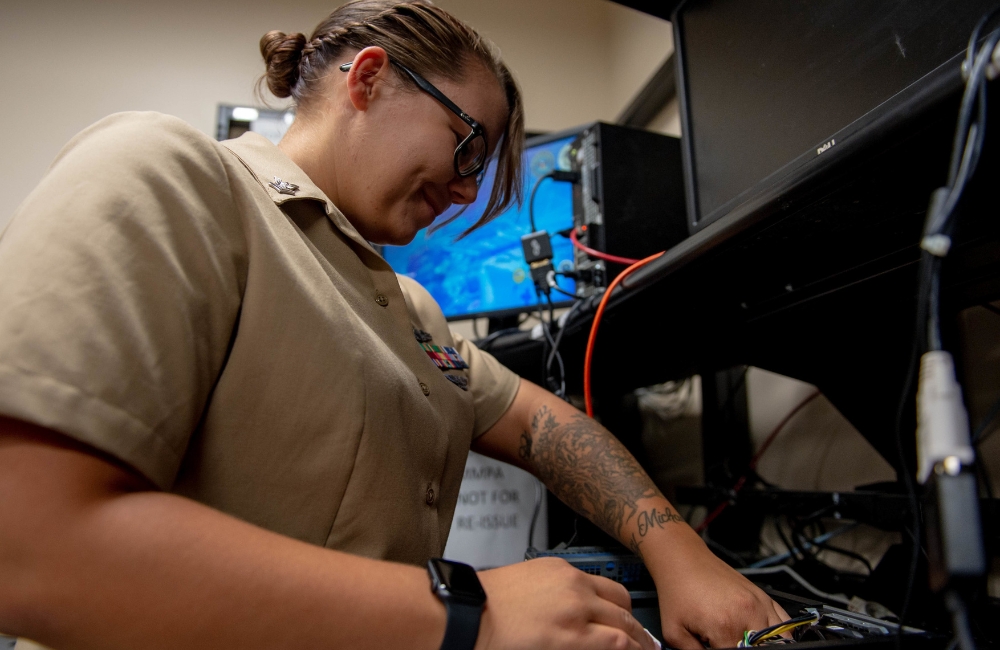Edge Computing Critical To JADC2 Success
The joint force needs transformational computing technologies to achieve JADC2.

Edge computing will play a critical role in the Defense Department’s efforts to implement the Joint All-Domain Command-and-Control (JADC2) concept to put actionable data in the hands of the warfighter, according to a Naval Information Warfare Center senior software engineer speaking at a MeriTalk event this week.
Various military platforms depend on sensors collecting enormous amounts of data to support multi-domain missions. Edge computing capabilities enable processing sensor data in real-time, analyzing and producing insights at mission-speed and interacting with captured data at various connectivity levels.
As the Department of the Navy’s edge computing architecture evolves, breaking down physical silos is a key area of concern.
“One of our challenges, specifically in the Navy … is almost every technology that comes to me, a piece of software tends to be delivered on a physical device,” Richard Jack, senior software engineer at NIWC PACIFIC, said at the MeriTalk Insights at the Edge panel. “So, how do I take it off the laptop? And so what we’re trying to do is democratize this capability in such a way that allows people to deliver us capability without delivering us the physical constraints that the software is being delivered upon.”
Successful edge computing, he added, keeps user experience top of mind.
“When I talked to the services, I think I tried to emphasize that we prioritize and emphasize understanding who our operators are. That is the most important concept to really get our heads around when we start talking about edge computing,” Jack said. “There’s a human capital behind this that I really like to think about. So that’s what I would advocate to all of our partners here as we go through these things.”
The way the capabilities are delivered needs to be simplified, he said, and the skill sets need to be more adaptable for warfighters to execute their mission.
“If we’re going to do that, we’re going to have to make it simpler,” Jack said. “If we’re going to provide capabilities to warfighters, that needs to be able to be operated by our sailors, marines, soldiers, and airmen that are actually going to use these capabilities.”
Machine learning (ML) and automation can also improve edge computing processing times.
“Machine learning is at our doorsteps. We’re starting to play around relative to how we’re actually going to enable mission effect with machine learning,” Rick said. “With that comes the burden of ‘how do we keep cadence with the accelerated pattern of the way we’re getting after this? You know, machine learning comes with a constant cadence of … being adaptable.”
Because of the distributed nature of DOD, data is always on the move, which puts the data at greater cybersecurity risk. To keep edge data secure, zero trust will be crucial to addressing the threat landscape and handling interconnected devices.
“If we think about tactical edge computing, the key cyber effects that we care about is really embracing those protections that are in place – proper encryption, excellent controls that we have in place,” Jack said. “Zero trust is going to be the key element … that’s going to help us really solve a lot of these problems. That is a journey by the way … It takes a while, it’s an important part of this.”
This is a carousel with manually rotating slides. Use Next and Previous buttons to navigate or jump to a slide with the slide dots
-

Doing More with Less is Muscle Memory for IRS, Former Deputy CIO Says
Darnita Trower discusses her experience, the legacy she’s left behind and how she pushed the IRS to modernize itself,
20m watch -

Opinion: Original Intelligence Is the Missing Piece for AI Transformation
Limitations of AI agents and development drive growing needs for workforce development and "original intelligence."
3m read -

VA CIO Targets Modern IT and Smarter Workforce Alignment
Agency leaders told lawmakers they are focused on trimming legacy systems and restructuring its workforce to streamline operations.
3m read -

Pentagon's $200M AI Contracts Signal Broader Effort to Transform Talent
The Army is leveraging Silicon Valley, reservist programs and new hiring strategies to integrate critical digital skills in its ranks.
5m read -

Inside DOD’s Push to Grow the Cyber Workforce Through Academia
Diba Hadi gives her first interview since becoming principal director of the DOD’s Cyber Academic Engagement Office.
15m listen -

Generative AI Demands Federal Workforce Readiness, Officials Say
NASA and DOI outline new generative AI use cases and stress that successful AI adoption depends on strong change management.
6m read -

Data Transparency Essential to Government Reform, Rep. Sessions Says
Co-Chair of the Congressional DOGE Caucus Rep. Pete Sessions calls for data sharing and partnerships to reduce waste and improve efficiency.
5m read -

DOD Turns to Skills-Based Hiring to Build Next-Gen Cyber Workforce
Mark Gorak discusses DOD’s efforts to build a diverse cyber workforce, including skills-based hiring and partnerships with over 480 schools.
20m listen -

Trump Executive Order Boosts HBCUs Role in Building Federal Tech Workforce
The executive order empowers HBCUs to develop tech talent pipelines and expand access to federal workforce opportunities.
3m read -

DOD Can No Longer Assume Superiority in Digital Warfare, Officials Warn
The DOD must make concerted efforts to address cyber vulnerabilities to maintain the tactical edge, military leaders said at HammerCon 2025.
4m read -

Tracking CIOs in Trump's Second Term
Stay informed on the latest shifts in federal technology leadership as new CIOs are appointed and President Trump's second term takes shape.
6m read -

DOL Turns to Workforce Development to Maintain AI Superiority
DOL is bridging the AI skills gap through partnerships and upskilling to ensure future AI workforce readiness.
10m watch




